a policy brief from ICPH
May 2013
Finding a job continues to be a challenge for many New Yorkers. In March 2013 the city’s jobless rate was 8.9%;1 for homeless families, unemployment was significantly higher, with some estimates at 57%.2 Yet work has become practically the only means out of shelter, as budget constraints have resulted in cuts to the programs that help homeless families get back on their feet. In this report, the Institute for Children, Poverty, and Homelessness (ICPH) explores the issue of employment among homeless families, including rates of work, job duration, occupation categories, and how these affect chances of making ends meet. Further, the report investigates families’ perceived barriers to gaining employment and underscores not only the need for targeted, population-specific supportive services for parents but also the reality that without additional work supports, employment is rarely enough for a homeless family to move into permanent housing.
Working Is the Only Way Up
While more than 46 million people are living in poverty in the United States,3 programs designed to help poor families move up the income scale are harder than ever to access. The primary form of cash assistance available to poor households is Temporary Aid for Needy Families (TANF), which limits aid to five years over one’s lifetime and requires that parents work for their benefits. New York State allows families who have exhausted their five-year TANF benefits to receive an additional five years of assistance through the Safety Net Assistance program.4 Until April 2012, New York City offered additional assistance to homeless families in the form of rental subsidies.5 However, the cessation of this assistance and the long waiting lists for public housing and Section 8 housing vouchers6 have left homeless families with no means of moving back into permanent housing beyond employment income.
Homeless and Working
To better understand employment among homeless families, ICPH surveyed homeless parents in 2011 with regard to employment status,7 education level, parent and child age, occupation, and perceived barriers to employment. Parents fell into four distinct categories: employed full-time, employed part-time, unemployed with a work history, and unemployed with no work history. As expected, levels of employment among homeless heads of household were far below those of the rest of the city, as just 31% of parents had paid positions, with 65% of those working full-time. The majority of parents (56.5%) were unemployed but had worked before. However, over 12% were unemployed and had no work history at all (see Figure 1). These rates are consistent with recent anecdotal reports that approximately 30% of homeless parents are employed.8
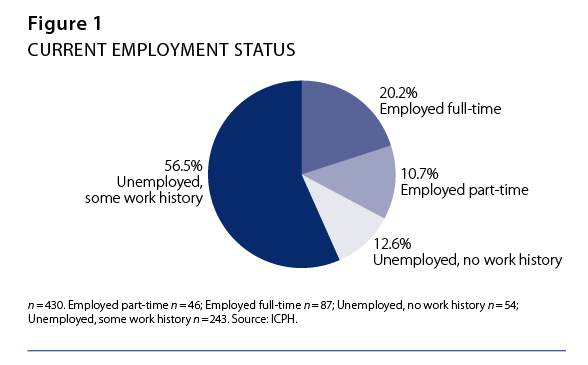
The number of parents with no work history decreased as age increased, from 16% for younger parents (aged 18–24 years), to 12% among 25-to-32-year-olds, to 9% for older parents (33 years and older). This relationship follows the expected trajectory, since older parents have had more opportunity to gain experience in the job market. However, the level of employment did not follow a parallel pattern, as parents in the middle age range (ages 25–32) represented the highest percentage of those currently employed (36%; see Figure 2).
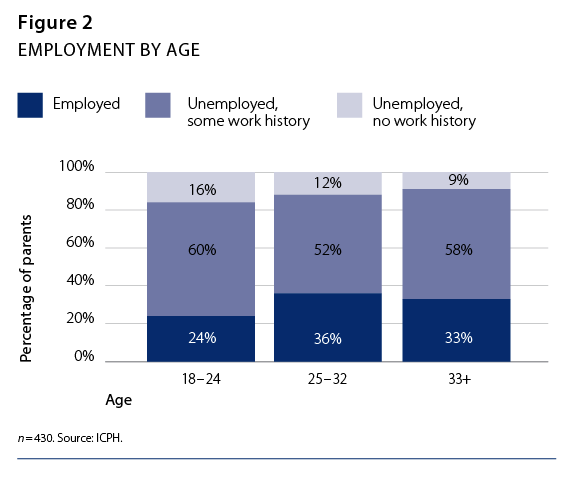
Age is pertinent to employment also because younger parents are more likely to have young children. As children under five are not yet in school, parents may choose to stay out of the workforce if they do not have alternative childcare arrangements that are affordable, accessible, and adequate.9 Ninety-one percent of young parents (18–24) had at least one child younger than five, while only 34% of older parents had a child under five (see Figure 3).

Despite this, the high rate of unemployment among older parents (67%; see Figure 2) suggests that factors besides parental caregiving responsibilities influenced employment decisions. This supports the contention that getting parents back to work is a complex undertaking that must address multiple concerns including, but not limited to, child care.
Social, emotional, and/or physical trauma also influences decisions about work. Research indicates that two-thirds of homeless mothers in the United States have a history of domestic violence; in addition, homeless mothers are three times as likely as low-income but stably housed women to suffer post-traumatic stress and twice as likely to be drug- or alcohol-dependent.10 Faced with the stresses of homelessness, 50% of mothers also report bouts of depression.11 Viewed in this light, an employment rate of 30% begins to make more sense.
In addition to parent age and trauma history, education levels provide insight into low employment rates. Higher levels of educational attainment were associated with employment among sampled parents. While one in four (26%) of those with less than a high school diploma were working, the number rose to one in three (34%) for those with a high school diploma and increased to 38% for parents with higher levels of education. Parents with more than a high school diploma are 31% more likely to be employed. This points to the importance of continuing efforts to promote high school completion and GED attainment. Education level also factored into the likelihood that a parent would have some past work experience; the percentage of heads of household without any work experience went from 17% among non–high school graduates to 4% for those with more than a high school diploma or GED. Education level did not, however, greatly influence levels of unemployment, which were steady between 56% and 58% for all three groups among those with work experience (see Figure 4). Again, this reinforces the view that employment services should be targeted to the specific needs and situations of different groups.
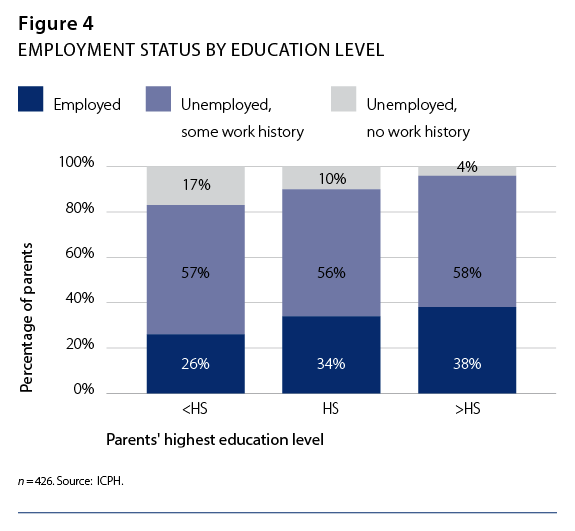
The Limitations of Work
While having a job is a step in the right direction, it does not always ensure that a family can make ends meet. The vast majority of homeless parents currently work or recently worked in low-wage jobs. The category in which the greatest number of heads of household had worked was health, child care, and personal services (26%), which includes the jobs of home-health aides, child-care workers, and beauticians (see Table 1). An additional 21% of employed and nearly 23% of unemployed parents worked or had worked in retail or sales, and 16% performed or had experience doing administrative or office work.

While the average hourly wage in New York State for these occupations is well above the minimum wage of $7.25 per hour ($11.05 for home-health aides,12 $13 for retail workers,13 and $14.05 for administrative office workers),14 these rates do not provide an annual income above the New York City poverty threshold for full-time workers15 (see Figure 5). In addition, many homeless breadwinners may not make the mean wage or work full-time. Also problematic is that these jobs are often the most inflexible, with parents penalized for taking time off to care for sick children, forcing some families to choose between caregiving responsibilities and employment.16 Recently passed legislation mandating sick leave in New York City will hopefully aid parents who are juggling family and work needs.
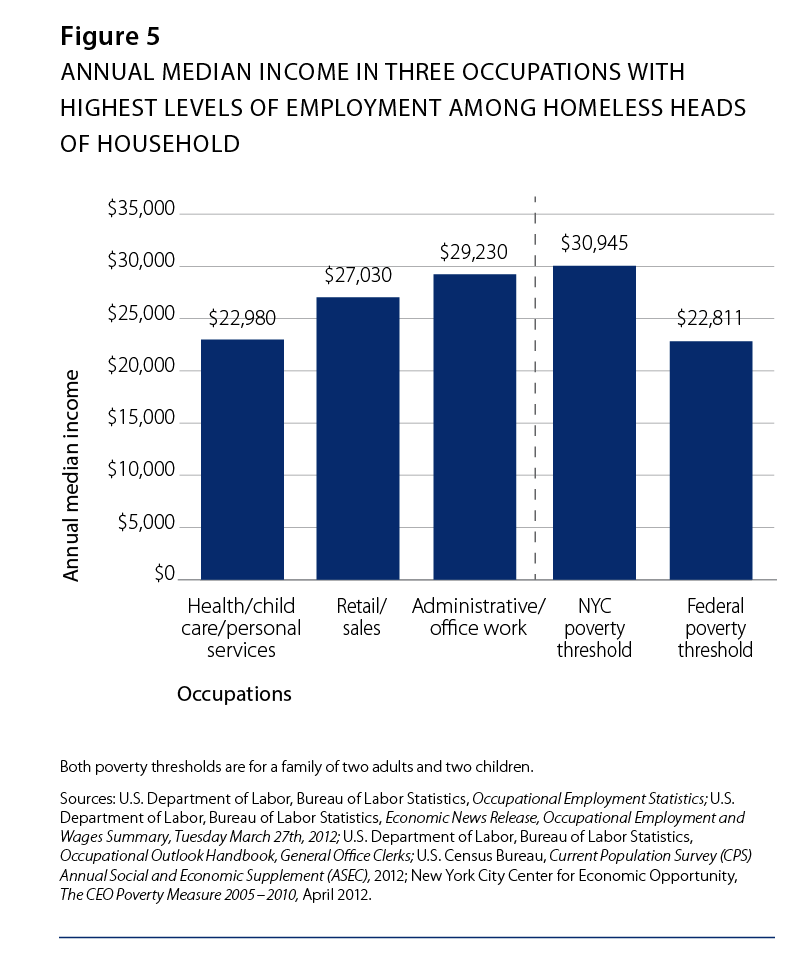
Even at the average wage for these jobs, affording New York City’s median rent for a two-bedroom apartment with utilities at a cost of over $1,400 per month is a stretch.17 A family would need to earn over $56,000 for a two-bedroom apartment to be considered affordable at 30% of their income. The low wages pervasive in the occupations of most homeless parents cause many families to live on the border of self-sufficiency and dependence. Unless parents are able to obtain better-paying jobs, this is unlikely to change.
Barriers to Employment
Neither parent age, trauma history, education, nor the presence of young children can fully explain the low levels of employment among homeless heads of household. Non-working parents (including those without a work history) reported seven major barriers to employment (see Figure 6): 32% highlighted a lack of skills, experience, or adequate education, 28% a lack of jobs, and 13% a lack of child care. Addressing these three barriers would help almost 75% of homeless heads of household to overcome their single greatest perceived obstacle to employment.
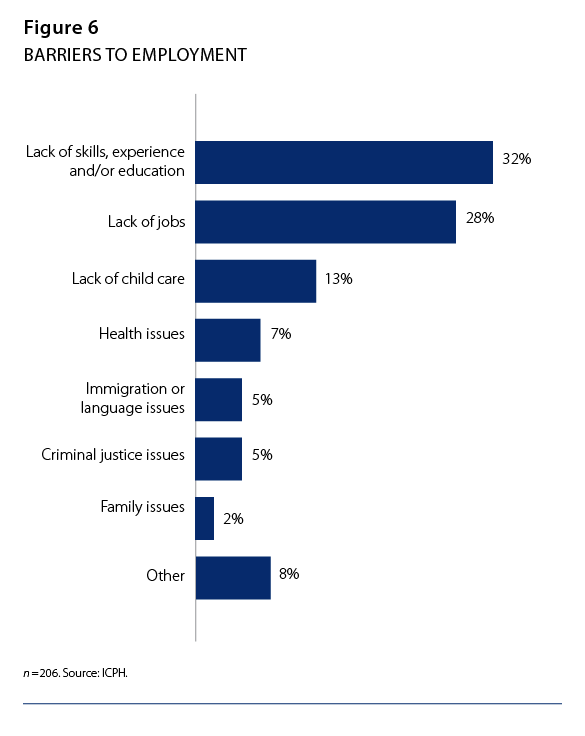
Focus on Education and Employment
Because employment is the only viable way for most homeless parents to attain self-sufficiency, it is imperative that they be given the opportunity to gain the skills needed for well-paid jobs, as well as access to child care.
The current shelter system in New York City must be transformed and utilized in a more strategic and cost-effective way. For far too many families, simply focusing on housing is a failed practice. Reorganizing the city’s shelter system would significantly reduce family homelessness by addressing actual needs. Homeless parents need specialized employment shelters that provide the job skills necessary to obtain and maintain stable, full-time employment in the current job market. Moreover, education-focused shelters would provide access to opportunities such as alternative high school, GED, and trade school programs that are vital to finding employment and continuing education.
If changes are not made to the current system, family homelessness will only continue to grow. As this report makes clear, before families are given housing subsidies and moved out of shelter, they need to be prepared to succeed with full-time, stable employment. With specialized service-provision shelters, we have the opportunity to create the long-term stability that would effectively break the cycle of homelessness for thousands of New York City children.
For more information about the specialized shelter programs mentioned above, please see A New Path: An Immediate Plan to Reduce Family Homelessness, available at www.ICPHusa.org.